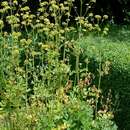en
names in breadcrumbs


Lovage (/ˈlʌvɪdʒ/), Levisticum officinale, is a tall perennial plant, the sole species in the genus Levisticum in the family Apiaceae, subfamily Apioideae.[1][2] It has been long cultivated in Europe, the leaves used as an herb, the roots as a vegetable, and the seeds as a spice, especially in southern European cuisine.
Lovage is an erect, herbaceous, perennial plant growing to 1.8–2.5 m (6–8 ft) tall, with a basal rosette of leaves and stems with further leaves, the flowers being produced in umbels at the top of the stems. The stems and leaves are shiny glabrous green to yellow-green and smell somewhat similar to celery when crushed. The larger basal leaves are up to 70 cm (28 in) long, tripinnate, with broad triangular to rhomboidal, acutely pointed leaflets with a few marginal teeth; the stem leaves are smaller, and less divided with few leaflets. The flowers are yellow to greenish-yellow, 2–3 mm (1⁄16–1⁄8 in) diameter, produced in globose umbels up to 10–15 cm (4–6 in) diameter; flowering is in late spring. The fruit is a dry two-parted schizocarp 4–7 mm (3⁄16–1⁄4 in) long, mature in autumn.[3]
Levisticum officinale is native to Afghanistan and Iran, [4] but has been introduced to most of Europe, and parts of South-East Asia, North and South America.[4] It has been long cultivated in Europe, the leaves being used as an herb, the roots as a vegetable, and the seeds as a spice, especially in southern European cuisine.[5]
The leaves can be used in salads, or to make soup or season broths, and the roots can be eaten as a vegetable or grated for use in salads. Its flavour and smell are reminiscent both of celery and parsley, only more intense and spicy than those of either. The seeds can be used as a spice in the same way as fennel seeds.[5]
The roots, which contain a heavy, volatile oil, are used as a mild aquaretic.[11] Lovage root contains furanocoumarins which can lead to photosensitivity.[12]
The name "lovage" is from "love-ache", ache being a medieval name for parsley; this is a folk-etymological corruption of the older French name levesche, from late Latin levisticum, in turn thought to be a corruption of the earlier Latin ligusticum, 'of Liguria' (northwest Italy), where the herb was grown extensively.[13] In modern botanical usage, both Latin forms are now used for different (but closely related) genera, with Levisticum for (culinary) lovage, and Ligusticum for Scots lovage, a similar species from northern Europe, and for related species.[13]
{{cite journal}}: CS1 maint: multiple names: authors list (link) Lovage (/ˈlʌvɪdʒ/), Levisticum officinale, is a tall perennial plant, the sole species in the genus Levisticum in the family Apiaceae, subfamily Apioideae. It has been long cultivated in Europe, the leaves used as an herb, the roots as a vegetable, and the seeds as a spice, especially in southern European cuisine.